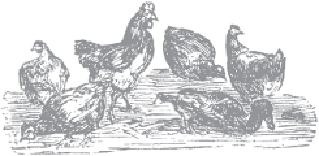Agriculture Reference
In-Depth Information
18
Incubation
THE EASIEST WAY TO INCREASE YOUR
flock size is to buy new stock every year or two
when you need to replace layers; you can also add to your flock on a yearly or quarterly
basis if you are raising broiler chickens. But nothing about simply purchasing your birds
matches the rewarding educational experience of hatching your own. Hatching your own
can be accomplished by using two general approaches: use broody hens or buy an incub-
ator. Each of these options has advantages and disadvantages.
Using Hens to Hatch Eggs
Prior to the advent of electricity, kerosene incubators were used to hatch eggs, along with
naturally setting (broody) hens. But before even the crudest incubators were used, the
hens were the only option, and they did an excellent job of carrying out the cycle of life.
Broodiness
, or the desire to be a mother, is a trait that not all poultry breeds possess.
Chickens
Broodiness is a quality not commonly found in the white egg-laying breeds such as the
Leghorns, Anconas, Catalanas, Campines, Brabanters, Lakenvelders, Hamburgs, or any
breeds of crested fowl. These breeds are genetically devoid of the mothering instinct and
have always relied upon others to do the mothering for them. It's extremely unlikely that
they'll go broody, and if they do, they'll rarely set on the eggs for the complete 21-day
incubation period.
Other breeds are known for their excellent broodiness and mothering ability; these
include the Dorkings, and most all of the Orientals (Shamos, Cubalayas, Kraienkoppes,
and Phoenix). Cochins, Orpingtons, and Wyandottes also make good brood hens. Most
Rocks, Giants, and Hollands are only average broody hens.
I have always found the Dorkings to be the most determined large-chicken mothers.
Silkies are the top setters for bantams. Shamos also make good setters and they are fierce

